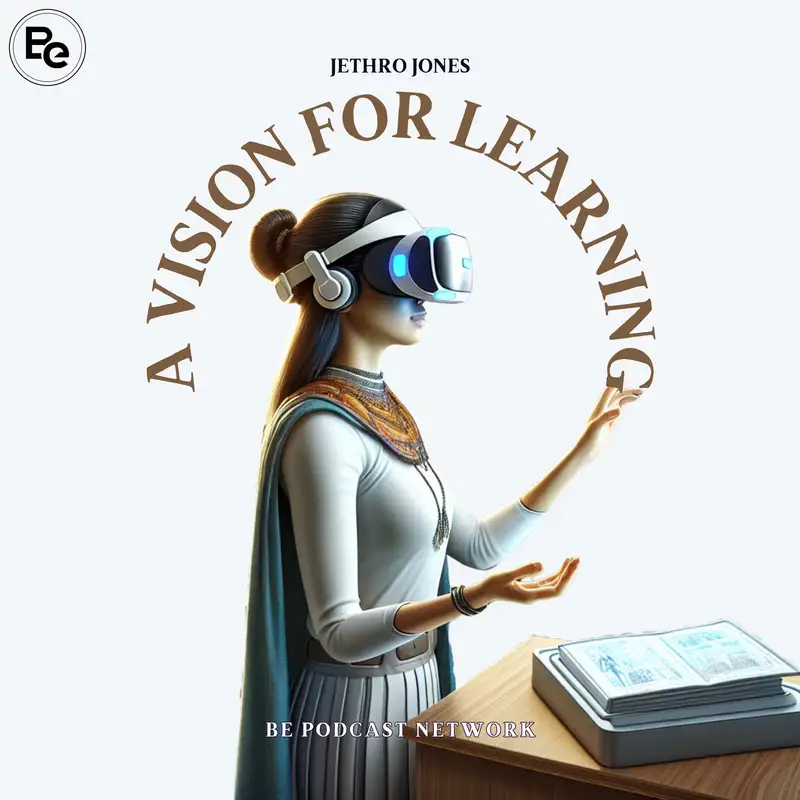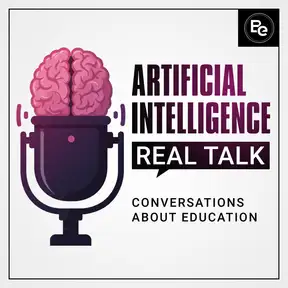Should I Buy the Apple Vision Pro for School Use?
Download MP3Welcome to A Vision for Learning with your host, Jethro Jones. Follow me on social media @jethrojones. Today's question: Should I buy this for use in school? Can it be a tool in school? Is it too costly? Should every student have one? Is it worth it? I've used it since its release last week. It's great for productivity, and some features are incredible, like reading. But let's discuss its use for school.
Apple designed a few things from the start that matter. First, they created an easy-to-access guest mode as a default. It lets you share the device with others and decide if they can access all apps or only opened ones. You can also choose to mirror the display on another device, like a Mac computer or Apple TV.
Another education tool is guided access, an accessibility feature that keeps the device in a specific app. It allows you to set up a passcode and restrict users to the chosen app, preventing them from accessing other apps. This can be useful in educational settings to focus students on the task at hand.
So, should we use this device for school? Consider its features and weigh the benefits against the costs before making your decision.
wants to escape, a separate passcode is needed, distinct from your optic ID. You can share it or keep it secret. If you want students to focus on one app, you can set that up. A challenge: once removed, you must recalibrate for each user. This could be time-consuming but also a learning opportunity.
With fingers as input and eye tracking, there's no need for controllers. My oldest daughter with Down syndrome quickly figured it out. A side note: when using guest access and turning on mirroring, the tool to invoke mirroring is always visible and easy to tap accidentally. This can be frustrating for new users.
Apple designed this device for people over 13, possibly due to its size. It doesn't fit smaller heads well. When my 12-year-old tried it, she had to hold it up to keep it on her face.
and maintaining eye alignment proved challenging. However, placing a beanie on her head resolved the issue, allowing hands-free use and unobstructed IR blasters and cameras.
Firstly, guest mode and guided access are crucial. Secondly, the device isn't designed for young children. Thirdly, while sturdy, it's also delicate. Kids can become immersed in the experience, making it nerve-wracking for parents. Exercise caution with children using the device.
Apple recommends covering the glass front. With kids and glass being a risky combination, extreme caution is advised. Additionally, the screens viewed by users are rumored to cost a thousand dollars each.
The band attaching to the headset detaches easily, so avoid carrying it by the strap. Instead, place your thumb on the nose area and two fingers on top when handling it.
Regarding eye health concerns, an ophthalmologist will join me in a future discussion. The device has screens inches away from users' eyes, raising potential questions about long-term effects on vision.
Away from my eyes for hours, I haven't experienced the same reaction as staring at my phone for lengthy periods. A couple of differences exist. Firstly, I sit up straighter. Secondly, I focus more on posture and positioning due to the large device on my head, ensuring it stays in place. A sudden movement made me feel discomfort in my neck and back, reminding me to be cautious about how I move.
Regarding eye strain, I haven't felt the fatigue usually associated with computer screens or iPads. When I have an ophthalmologist on the show, I hope to gain insight into this phenomenon. Will VR cause similar eye strain? Research is needed to determine this.
Interestingly, a company uses VR to treat lazy eye. Instead of wearing an eye patch, children can watch a show in VR goggles for an hour daily to address the issue.
Now let's discuss cost. At $3,500, this device may seem expensive for children. Cheaper VR alternatives exist; however, one significant advantage is the Apple ecosystem of apps already available. Many iPad apps could likely be used similarly on the Apple Vision Pro.
Ultimately, the real benefit will be apps designed specifically for this device.
I'm eager to see what's available for the Apple Vision Pro. Vijay Ravindran discussed Floreo, utilizing virtual reality headsets to help those with autism interact better. These use cases are incredibly powerful as they address challenges in teaching and open doors for individuals with disabilities by custom designing experiences.
If you're already using apps with your students, many will likely work with the Vision Pro right away. But should you get it for your school? That depends on factors like the age of your students, their ability to handle expensive devices, and the comfort level of wearing it.
Take Jig Space, an app that allows users to explore an F1 car and other complex objects in three dimensions. It's impressive and has the potential to change education significantly. While not the first virtual reality headset, the difference lies in Apple's existing ecosystem of compatible apps.
Last week, Shannon Putman and I discussed intrinsic versus extrinsic motivation and how such technology could motivate students. There are numerous apps already created that can be integrated into the classroom experience.
In the midst of the Apple Vision Pro release, various apps are designed as rewards. One app, especially suitable for schools, is called Illustrated. This Apple Arcade game features puzzles where students recreate famous paintings like those in the Van Gogh Museum. Each painting has a story and description, making it an educational experience.
The Apple Vision Pro encourages creative app development, and I anticipate unique creations for educational purposes. If you use it in schools, contact me; I'd love to discuss its impact on education.
After a few days with the Apple Vision Pro, I'm eager to hear from those using it in school settings. Reach out and share your experiences, cool apps, and how they work or don't. Thank you for listening to A Vision for Learning. Share this with friends and leave a review on Apple Podcasts or Spotify. Ensure it's five stars with kind words. See you next time on A Vision for Learning.
Apple designed a few things from the start that matter. First, they created an easy-to-access guest mode as a default. It lets you share the device with others and decide if they can access all apps or only opened ones. You can also choose to mirror the display on another device, like a Mac computer or Apple TV.
Another education tool is guided access, an accessibility feature that keeps the device in a specific app. It allows you to set up a passcode and restrict users to the chosen app, preventing them from accessing other apps. This can be useful in educational settings to focus students on the task at hand.
So, should we use this device for school? Consider its features and weigh the benefits against the costs before making your decision.
wants to escape, a separate passcode is needed, distinct from your optic ID. You can share it or keep it secret. If you want students to focus on one app, you can set that up. A challenge: once removed, you must recalibrate for each user. This could be time-consuming but also a learning opportunity.
With fingers as input and eye tracking, there's no need for controllers. My oldest daughter with Down syndrome quickly figured it out. A side note: when using guest access and turning on mirroring, the tool to invoke mirroring is always visible and easy to tap accidentally. This can be frustrating for new users.
Apple designed this device for people over 13, possibly due to its size. It doesn't fit smaller heads well. When my 12-year-old tried it, she had to hold it up to keep it on her face.
and maintaining eye alignment proved challenging. However, placing a beanie on her head resolved the issue, allowing hands-free use and unobstructed IR blasters and cameras.
Firstly, guest mode and guided access are crucial. Secondly, the device isn't designed for young children. Thirdly, while sturdy, it's also delicate. Kids can become immersed in the experience, making it nerve-wracking for parents. Exercise caution with children using the device.
Apple recommends covering the glass front. With kids and glass being a risky combination, extreme caution is advised. Additionally, the screens viewed by users are rumored to cost a thousand dollars each.
The band attaching to the headset detaches easily, so avoid carrying it by the strap. Instead, place your thumb on the nose area and two fingers on top when handling it.
Regarding eye health concerns, an ophthalmologist will join me in a future discussion. The device has screens inches away from users' eyes, raising potential questions about long-term effects on vision.
Away from my eyes for hours, I haven't experienced the same reaction as staring at my phone for lengthy periods. A couple of differences exist. Firstly, I sit up straighter. Secondly, I focus more on posture and positioning due to the large device on my head, ensuring it stays in place. A sudden movement made me feel discomfort in my neck and back, reminding me to be cautious about how I move.
Regarding eye strain, I haven't felt the fatigue usually associated with computer screens or iPads. When I have an ophthalmologist on the show, I hope to gain insight into this phenomenon. Will VR cause similar eye strain? Research is needed to determine this.
Interestingly, a company uses VR to treat lazy eye. Instead of wearing an eye patch, children can watch a show in VR goggles for an hour daily to address the issue.
Now let's discuss cost. At $3,500, this device may seem expensive for children. Cheaper VR alternatives exist; however, one significant advantage is the Apple ecosystem of apps already available. Many iPad apps could likely be used similarly on the Apple Vision Pro.
Ultimately, the real benefit will be apps designed specifically for this device.
I'm eager to see what's available for the Apple Vision Pro. Vijay Ravindran discussed Floreo, utilizing virtual reality headsets to help those with autism interact better. These use cases are incredibly powerful as they address challenges in teaching and open doors for individuals with disabilities by custom designing experiences.
If you're already using apps with your students, many will likely work with the Vision Pro right away. But should you get it for your school? That depends on factors like the age of your students, their ability to handle expensive devices, and the comfort level of wearing it.
Take Jig Space, an app that allows users to explore an F1 car and other complex objects in three dimensions. It's impressive and has the potential to change education significantly. While not the first virtual reality headset, the difference lies in Apple's existing ecosystem of compatible apps.
Last week, Shannon Putman and I discussed intrinsic versus extrinsic motivation and how such technology could motivate students. There are numerous apps already created that can be integrated into the classroom experience.
In the midst of the Apple Vision Pro release, various apps are designed as rewards. One app, especially suitable for schools, is called Illustrated. This Apple Arcade game features puzzles where students recreate famous paintings like those in the Van Gogh Museum. Each painting has a story and description, making it an educational experience.
The Apple Vision Pro encourages creative app development, and I anticipate unique creations for educational purposes. If you use it in schools, contact me; I'd love to discuss its impact on education.
After a few days with the Apple Vision Pro, I'm eager to hear from those using it in school settings. Reach out and share your experiences, cool apps, and how they work or don't. Thank you for listening to A Vision for Learning. Share this with friends and leave a review on Apple Podcasts or Spotify. Ensure it's five stars with kind words. See you next time on A Vision for Learning.
- (00:00) - Should I buy this for School Use?
- (00:53) - Exploring the Use of Technology in Schools
- (01:58) - Designed for Sharing
- (06:02) - 2. Guided Access
- (07:46) - 3. Sturdy Device, but Delicate
- (09:45) - 4. Exploring the Impact on Eye Health and Posture
- (12:05) - Cost Considerations and the Power of App Ecosystem
- (14:19) - Some App Examples
- (18:07) - Reach out to me if you're using the Apple Vision Pro in Schools
We’re thrilled to be sponsored by IXL.
IXL’s comprehensive teaching and learning platform for math, language arts, science, and social studies is accelerating achievement in 95 of the top 100 U.S. school districts. Loved by teachers and backed by independent research from Johns Hopkins University, IXL can help you do the following and more:
- Simplify and streamline technology
- Save teachers’ time
- Reliably meet Tier 1 standards
- Improve student performance on state assessments
🚀 Ready to see why leading districts trust IXL for their educational needs? Visit IXL.com/BE today to learn more about how IXL can elevate your school or district.
Creators and Guests

Host
Jethro Jones
Author of #SchoolX #how2be Co-Founder of @bepodcastNet, the best education podcasts out there.

